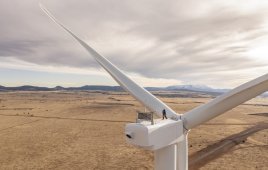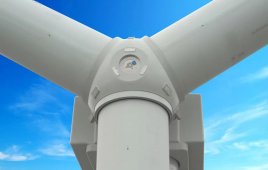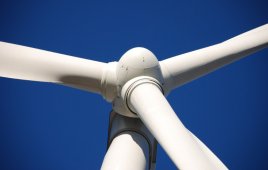
FiberSIM generates a solid model of a composite blade skin and spar directly from the ply and laminate definition (root area shown here). This can be used for mock-up and visualization, interference checking, and to shape tooling surfaces.
Observers of the wind-energy industry agree that long term growth will require technical innovation to make wind power more competitive with other forms of energy. There is also a consensus that it is critical to improve performance by designing and manufacturing more efficient, reliable, and lighter blades that can reduce loads on main-turbine components and significantly lower total system costs.
However, as designers shape every larger blades (the longest now reach 150 to 200 ft), materials, design methods, and manufacturing processes are reaching their limits due to weight, cost, and reliability issues. The wind industry requires new design tools and manufacturing methods to rapidly develop and produce larger blade designs that are cost effective and reliable.
Vistagy Inc., Waltham, Mass., developer of FiberSIM software, says it provides a useful environment for composites engineering. It works with commercial 3D CAD systems and the company says it has been at the forefront of composites development and the aerospace industry for nearly 20 years. The software supports the complex design and manufacturing methods necessary to engineer durable and lightweight composite turbine blades. The software has several benefits for wind energy manufacturers, such as:
• Shorter design-to-manufacturing cycles so more design iterations can be performed
• An integrated approach to analysis and design to improve performance and reduce weight
• Early identification and resolution of part and tooling design issues for improved manufacturing accuracy and quality
• A seamless link from the 3D model to manufacturing
• Support for manufacturing automation
Early in a design cycle, the FiberSIM zone-based design method combines finite element analysis requirements for multiple zones with target laminates critical for designing and manufacturing a blade that will withstand load cases that represent the rigors of wind and weather.

The FiberSIM simulation highlights fiber orientations that deviate from specifications when materials are draped over a complex curve. The software highlights excessive deviation in red and moderate deviation in yellow. These alert engineers to potential manufacturing problems.
Zone-based design automates the generation of the often several hundreds of plies and cores in a blade. The software also manages staggered ply transitions and overlaps between plies. A Variable Surface Offset feature creates laminate-over-core and B-surfaces to better engineer blade assemblies of skins, spars, and shear webs. Detailed ply designs are captured complete with design and manufacturing data, including laminate, rosette, ply, and core data. Manufacturing data, such as technical drawings, cut files, and laser positioning are then exported for a variety of manual and automated tasks.
Filed Under: Turbines




